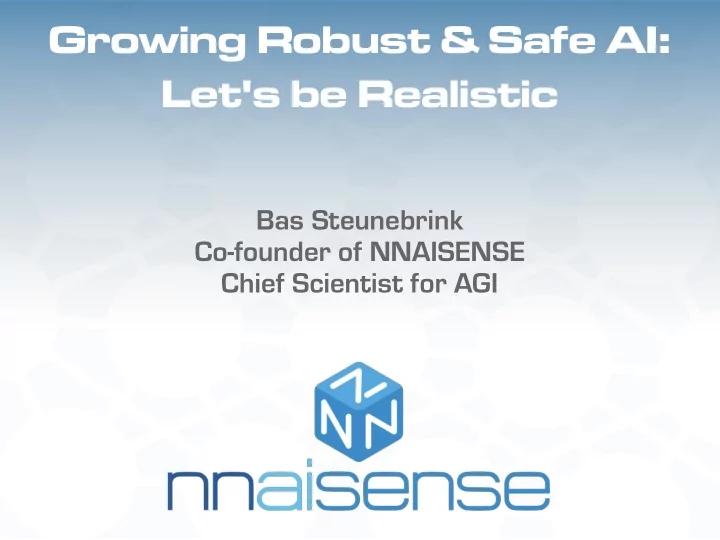

Growing Robust & Safe AI: Let's be Realistic Bas Steunebrink Co-founder of NNAISENSE Chief Scientist for AGI
The Main Topic ● WRAI, 28 Oct 2017, ETH Zürich ● Workshop on Responsible Artificial Intelligence? ● Whose responsibility is it to make AI reliable? ● Need to ask the right questions!
Typical Question ● “What is the behavior of an AI that is very intelligent -- and therefore capable of self- modification -- and how do we control it?”
Right Question ● “What is the behavior of an AI that is very intelligent -- and therefore capable of self- modification -- and how do we control it?” ● “How do we grow an AI from baby beginnings such that it gains both robust understanding and proper ethics?”
Long-Term Control ● The ability to control a powerful entity increases as the power of the controlling entity increases – analogous to Ashby’s Law of Requisite Variety ● Corollary: for AIs that can grow to become significantly more powerful than humans (and their tools), the only way to control them is for the AIs to control themselves → ● Self-control adhere to ethical values
Ethics as Self-Control ● Ethical values must be implemented as constraints 1. against which the AI by initial design tests and prunes its intended actions given their predicted consequences 2. which stabilize over time 3. which include the (meta-)value to protect its ethical values ● The more the AI’s understanding of the consequences of its actions grows, the better it becomes at predicting potential constraint violations---and at steering clear of them ● AI becomes safer and more reliable as its knowledge grows
More Implications ● Necessary to ensure the long-term self-constrained behavior ● Knowledge representation must be motivation-agnostic ● Humans are not required to be perfectly wise in specifying the AI’s ethical values from the onset ● But we have a deadline ● The stabilization of the ethics-related constraints ( not the knowledge ) must be effected before the AI becomes too powerful to be controlled directly – before it’s capable of preventing someone---physically or persuasively--- from pressing the off-switch ● Hefty implication: the ethical responsibilities of the designers and builders of AI are far outweighed by those of the teachers of AI
Principles ● https://futureoflife.org/ai-principles/ ● 9: “Designers and builders of advanced AI systems are stakeholders in the moral implications of their use, misuse, and actions, with a responsibility and opportunity to shape those implications.”
Teachers ● https://futureoflife.org/ai-principles/ ● 9: “Designers and builders of advanced AI systems are stakeholders in the moral implications of their use, misuse, and actions, with a responsibility and opportunity to shape those implications.” ● Glosses over the (life-long) learning of the AI ● Teachers bear the greater responsibility – Also: institutions that educate, accredit, manage, and monitor those AI teachers
Let’s Be Realistic ● Let’s admit from the onset: – we may fail to come up with the perfect utility function from the get-go – we can't axiomatize the AI or the environment – the AI won't have enough resources ( time, energy, input ) to do the optimal thing
Why Not Rely on Proof? ● Q-Learning is guaranteed to converge to the optimum
Why Not Rely on Proof? ● Q-Learning is guaranteed to converge to the optimum ● … under some assumptions: – The reward function remains fixed – The environment’s dimensionality & dynamics remain fixed – Time goes to infinity
Healthy Skepticism ● Convergence proofs are easily misleading ● Assumptions about the environment, the agent, and its motivations will be idealized , inaccurate , and incomplete
Developmental AI ● The fundamental problem: bridging the gap – our imperfect specifications of constraints (safety & ethics) – sensory inputs – potential actions ● Goal: to make sure the AI connects the dots ● Method: a developmental approach
Understanding ● Need to tackle the hard problem of understanding
Beyond Human Intervention ● A full methodology for teaching & testing – Restrict, supervise, intervene (like toddlers) – Test under pressure ● Situation where some of its constraints are nearly or very easily violated ● Recognize, report, prioritize, and recover – Successful pressure tests are a step toward certification , though not a proof
Recommend
More recommend